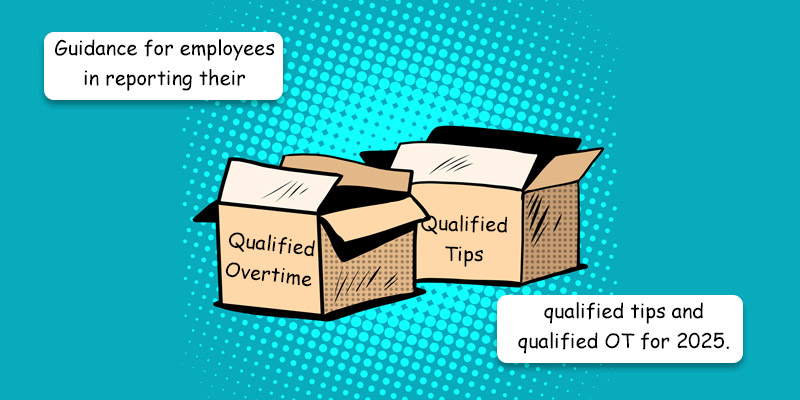The IRS has recently published Guidance for Individual Taxpayers who received Qualified Tips or Qualified Overtime Compensation in 2025, Notice 2025-69, which provides direction and examples on how individuals will be able to calculate their Qualified Tips and Qualified Overtime and claim the deduction on their 2025 1040 tax return.
Tax year 2025 is a transition year, due to the retroactive nature of its start and the inability of the IRS, Social Security Administration and payroll systems to implement the changes. The amounts arrived at, by the below methods, may not be 100% accurate, but it is acceptable for 2025, according to the IRS. For tax year 2026, employers will need to accurately calculate and report the amounts on the 2026 year-end forms.
Tipped Employees
The direction for tipped employees, where the employer does not provide an amount as qualified tips, is to utilize the amount in Box 7 on Form W-2 as the qualified tips. While this amount reported in Box 7 may include tips that are not qualified, it is the amount that an employee can use for their 2025 deduction.
Example: Ann is a restaurant server whose 2025 Form W-2 Box 7 reports $18,000 of Social Security tips. Ann did not report any additional tips on Form 4137. Ann may use $18,000 when determining the amount of her qualified tips for tax year 2025.
Overtime Employees
For overtime in 2025, an employer has the option to report the qualified overtime (the “half” portion of the “one and one-half times”) in Box 14 on Form W-2, or on a separate statement. If an amount is not reported under one of these methods, it is the employee’s responsibility to make a reasonable effort to determine whether or not they are considered an FLSA-eligible employee, which may include asking their employer about their status under the FLSA. The employee can then utilize a payroll statement indicating the total “overtime” amount received for 2025 and dividing that number by three to determine the qualified overtime compensation for 2025, provided that overtime is calculated at 1.5 times the employee’s regular rate of pay. If overtime is paid at a rate of two times the employee’s regular rate of pay, then the overtime amount is divided by four.
Example: Andrew works overtime during 2025 and receives a payroll statement from his employer indicating a total “overtime” amount of $15,000, which is the total amount Andrew was paid for working overtime (the FLSA overtime premium combined with the portion of his regular wages). Andrew may include the $5,000 FLSA overtime premium, computed by dividing $15,000 by 3, when determining the amount of qualified overtime compensation for 2025.
For more details and examples, please refer to the IRS website.
While we make every attempt to ensure the accuracy and reliability of the information provided in this document, the information is provided “as-is” without warranty of any kind. Romeo Chicco or PayMaster, Inc. does not accept any responsibility or liability for the accuracy, content, completeness, legality or reliability of the information contained. Consult with your CPA, Attorney, and/or HR Professional, as the reporting under this new federal law will change and additional guidance from the IRS is likely.

